Media | Articles
Is a Trans Am the best alternative to Buick’s GNX?
Want a better understanding of what’s driving collector-car values? Sign up for the Hagerty Insider newsletter.
Can a substitute ever be as satisfying as the real thing? It’s a question with which we all seem to struggle from a young age. It’s not always broccoli versus ice cream, either—often, the comparison is much closer, like Matchbox versus Hot Wheels. Each has its high points, and though you may prefer one, and all the hype tells you that it’s superior, the other just might impress if you give it a chance.
Take the 1987 Buick GNX and the 1989 Pontiac Trans Am 20th Anniversary Edition: they’re the protagonists in what might be the ultimate ’80s domestic-substitution challenge. Since the Black Buick’s prices remain stratospheric, could it be that the best alternative comes from cross-town Pontiac?
We can see the furrowed brows of the Buick faithful through the screen. Yes, you’ve got a point—despite nearly identical drivetrains, the differences between the Buick and the Poncho are black and white, much like the sole color choice offered on each car. Besides, wouldn’t a lesser-trim Regal scratch that GNX itch without the GNX price tag? Buick built thousands of the turbo Regal variants between 1978 and 1987, from the super-niche 1987 Turbo Regal Limited (1035 produced) to the more garden-variety Grand Nationals and T-Types, and they cover a broad price spread, too. But, if you want a range-topping, Ferrari-eating, force-fed piece of ’80s American history, and you like your cars ultra-rare, it’s either the GNX or the ’89 turbo T/A.
This turbo turf war has its roots in 1978, when Buick made quite the pivot. Hailing from the city that forged the formula for the V-8 muscle car, the Regal Sport Coupe’s fancy turbocharged 3.8-liter V-6 debut signaled a new path to power. Sure, its 165 hp and 245 lb-ft of torque did little to evoke the tire-evaporating 455 in Buick’s departed GS, but it was a step in the right direction. (It was also the only turbocharged domestic on the market that year, with Porsche, Saab, and Mercedes-Benz the only others with turbocharged models in the U.S.)
Marketplace
Buy and sell classics with confidence
Oldsmobile and Chevy experimented with turbos in the ’60s, but they dropped the comparatively complex, boosted engines from their lineups relatively quickly. Pontiac would add a turbo to the 4.9-liter V-8 in the 1980 and ’81 Trans Am, but of GM’s brands, it was Buick that committed to the technology.
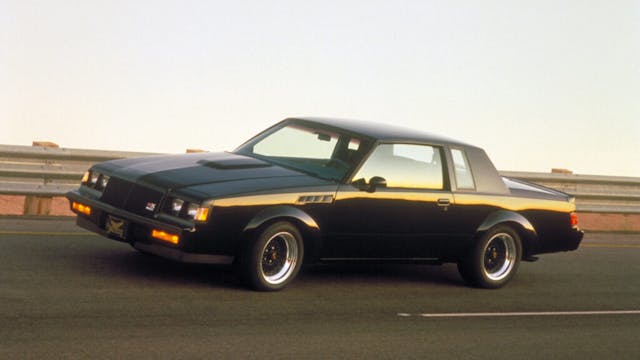
Sticking with forced induction led to increasingly powerful—if outwardly mundane—Buick Regals roaming the streets in the early ’80s. The Grand National nameplate emerged in 1982 as an aesthetic and interior celebratory package for Buick having won the Manufacturer’s Cup in the NASCAR Winston Cup Grand National Series. Available on base-engine Regals or the Regal Sport Coupe with the turbo, the ’82 Grand National was the first step in building the bad-boy visual for Buick’s turbo coupes.
Though you could pick out a Regal T-Type (the turbocharged trim that replaced the Sport Coupe) in a variety of colors, 1984 marked first year of the black-only Grand National, its 200-hp and 300-lb-ft rating, and its TV ads with a Buick-ized version of George Thorogood’s “Bad to the Bone.” People took notice. Buick subsequently made incremental improvements in engine management, intercooling, and ignition to pressurize their variety of turbo Regal trims until the blown Buick crept into into Corvette power territory in 1987 with 245 hp and 355 lb-ft of torque.
By then, word was out. In addition to the turbo Regal’s reputation for speaking softly and cruising with a big stick, 1987 would be the final year for rear-wheel drive Regals. Turbo Buick fans came out in droves to snap up 27,590 units across all trims, or more than three times those sold in 1986.

Ahead of this sunset, Buick decided a commemoration was appropriate and got going on the ultimate second-gen Regal—the GNX. It reached out to Automobile Specialty Company (a division of American Sunroof Company, whose initials also spelled ASC) and McLaren Engines (not to be confused with McLaren the automaker) to aid in building a limited run of high-test, blacked-out turbo goodness. One look at a GNX and you know it’s different than the standard GN, though not obviously so—subtle badges, fender vents, and flares surrounding black mesh wheels are the tells.
ASC/McLaren’s effort on the engine was more a thorough massage than a complete working over: Boost increased to 15 psi and flowed through a larger turbo with ceramic turbine wheel, and the computer got a more aggressive tune. A new, large-diameter dual exhaust helped the turbo breathe better while revised intercooler piping offered greater thermal efficiency. The result was an almost certainly underrated 276 horsepower and 360 lb-ft of torque, managed through a 200-4R transmission with a new valve body and put to pavement by a reconfigured rear end featuring an F-body-style torque arm, Panhard bar, and strengthened differential cover.
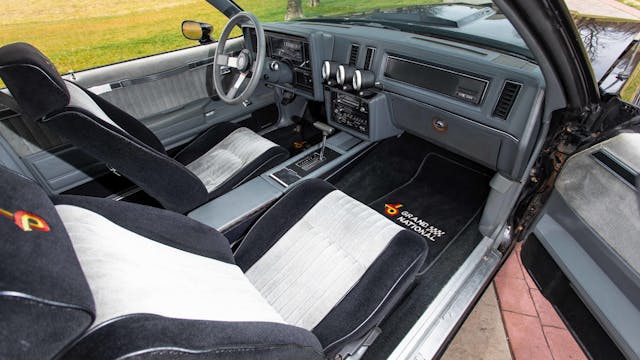
All that power launched the GNX to 60 mph in 4.7 seconds and a then-brutal quarter-mile result of 13.5 seconds at 102 mph in Car & Driver’s testing. On the strip, this was good enough to place Buick’s bruiser at the pointy end of the fastest production cars available. It’s best to keep GNXs on the straight and narrow, though: “Clearly, the engine and the chassis are in separate leagues,” wrote Tony Assenza in the May 1987 issue of Car & Driver. “What we have here is a great powerhouse of a motor looking for a nice place to live.”
That criticism and underwhelming chassis didn’t matter a lick. Enthusiasts knew what these cars were about and loved every inch of them. Buick produced a mere 547 GNXs, and buyers scooped them up in a frenzy, often paying well over the $29,389 MSRP. Between the brawny motor and badass reputation cultivated by the Grand National that preceded it, the top-dog GNX has enjoyed a strong secondary market from the beginning and its legendary status has long been secure.
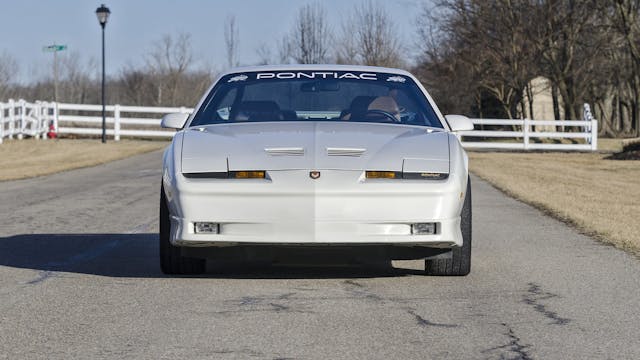
Younger readers might be surprised to learn GM didn’t always have a reputation as a monolithic corporation. For the first 50 years of operation, its many brand divisions operated semi-autonomously, each division utilizing and developing technology that was at times shockingly distinct from that of its corporate compatriots. In other words, Oldsmobile did its own thing, as did Cadillac, Buick, Chevy, GMC, and Pontiac. By the 1980s, GM chairman and CEO Roger Smith’s cost-cutting overhaul ushered in extensive tech trade and sharing between the GM siblings, but there was still significant internal competition.
So, while Pontiac was probably sick of its halo, 305-cubic inch, tuned-port injection Trans Ams losing drag races to Buick’s personal luxury coupes, it wasn’t above harnessing a bit of Buick’s turbo magic to remedy the situation. Pontiac decided to inject the turbo V-6 into the 20th Anniversary Trans Am, and started the project with its top-trim GTA model and all the WS6 handling upgrades.
Unique shocks and shorter front springs were swapped in to match the engine’s lighter-than-small-block weight, and larger brakes from the race-oriented 1LE package found their way behind the front wheels. A T-top roof configuration was an option, as were leather seating surfaces—though tan was the only interior color. Most turbo T/As came fully optioned with leather and the removable roof; finding a cloth interior or a hardtop is a challenge, much less finding one with both. Since the car paced the Indy 500 that year, pace-car door decals were included and installed by the dealer at the buyer’s discretion.
Despite a smaller footprint than the third-gen Firebird’s existing 305-cubic-inch V-8, the 3.8-liter six presented a fitment challenge. The Firebird’s strut towers made for a less accommodating bay than the larger Buick’s, so Pontiac swapped in compact cylinder heads from the 3800-series engine and selected shorter pistons to achieve its desired 8.0:1 compression ratio. Like Buick, Pontiac outsourced these tweaks, using Performance Automotive Systems to build the engines and complete final assembly.
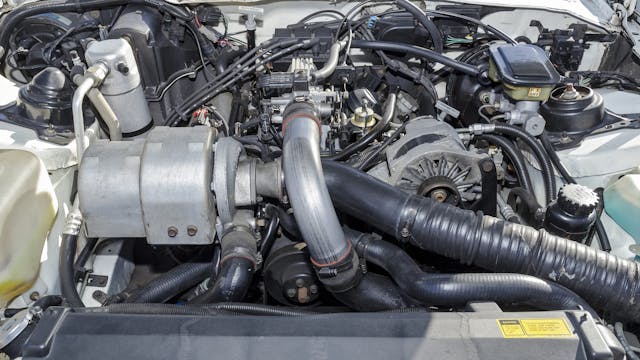
The remainder of the engine components were a mix and match of existing Buick parts and Pontiac-specific selections, yielding 250 horsepower and 340 lb-ft of torque—figures that, like the GNX, are considered substantially underrated. Despite being down 26 horses on paper against the GNX, Car & Driver reported that the turbo T/A was a tenth quicker both to 60 mph and through the quarter mile. Pontiac had bragging rights on a technicality—these straight-line numbers are effectively a dead heat, and it was anyone’s bet at a Woodward Avenue stoplight.
Fulfilling C&D’s wishes, the T/A’s chassis was a better fit for the Buick V-6’s prodigious power. The F-body exhibited greater balance and grip, and was overall a more complete performance package, if a bit less comfortable on the boulevard.
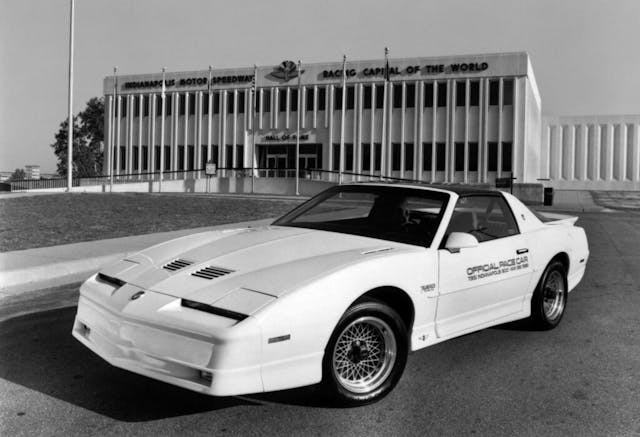
Sources put production at around 1550 turbo Trans Ams—still a very limited run, but nearly three times the amount of GNXs that reached showrooms. While it briefly stood at the top of the heap of domestic performance, it never gained the cult following that the GNX had. Add in the 20th Anniversary Trans Am’s lack of visual differentiation from the lesser Trans Am GTA, and you’ve got the proper mix to make it less valuable to collectors—and simultaneously an opportunity for those who want a usable, affordable classic.
As with many Radwood-era rarities, pristine examples of both cars have increased significantly in value, though the Buick stands head and shoulders above the Pontiac. Ten GNXs have sold on Bring a Trailer for $200,000 or more, and that’s not just from the hot heyday of the pandemic market—the first one on BaT to cross that mark did so in 2019.
Granted, these are almost exclusively museum pieces with minimal mileage and delivery plastic covering the seats, but they slot neatly in between the Hagerty Price Guide‘s #1 condition value of $288,000 and condition #2 (Excellent) $179,000 value. Even driver-quality, #4 condition GNXs sit at the $80,000 mark. Values have softened ever so slightly for all but the top-tier—prices peaked in July last year and have remained stable at slightly lower levels since then.
About 70 percent of quotes for the GNX come from Gen X, which is nearly double that generation’s share from three years ago. Boomers have seen their share of quotes taper to about 20 percent. Millennials are becoming more interested in the GNX, but their share is still only about 5 percent. Insured demographic shares are similar: Gen X leads with 59 percent, 26 percent are owned by boomers, seven percent are owned by millennials, and eight percent by pre-boomers.
In contrast, you could take home four (!) #1-condition turbo T/As for the price of a single #1-condition GNX, or one pristine example for less than a driver-quality GNX. Across all conditions, the Pontiac’s prices continued to rise for one quarter longer than the Buick’s. Unlike the GNX, which throttled back its values slightly before leveling off at the end of the year, the turbo T/A has held steady as the market has begun to cool. This lag and hold does suggest the possibility for a substitution effect, or at least for greater market recognition.
The T/A finds itself sought after by the two dominant generations in the market: boomers and Gen X. It’s not particularly surprising for a rare, niche model to appeal most to those who were alive when it debuted. Together, the two generations almost evenly split nearly 90 percent of the quotes sought for the turbo T/A. Millennial interest is slight. Policies indicate that Gen X owns 52 percent of the turbo Trans Ams insured with Hagerty, with boomers coming in at 38 percent. Millennials have a two percent share, and pre-boomers make up an eight percent share. The average insured value of ’89 turbo T/As is a staggering 4.8 times less than that of the GNX.
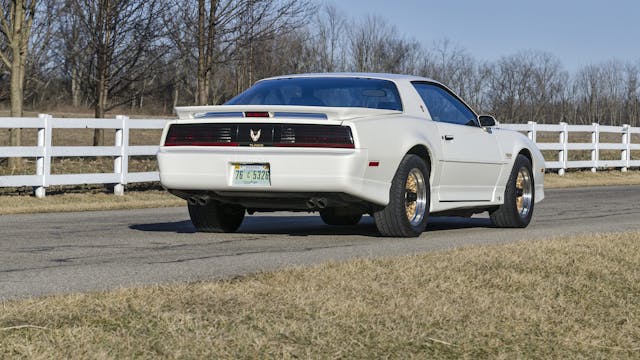
What does this massive delta in values come down to? Mythology and sinister looks that are the last gasp of the muscle-car-era silhouette—the big, bad Buick has those in spades, and they certainly help its appeal. Three-figure production numbers don’t hurt the GNX’s desirability, either. As for the Trans Am, it might be handsome but it’s not nearly as mean, and aside from some badging, it looks identical to its V-8-powered GTA-trim sibling. The pace car decals that adorn many of the cars are an acquired taste as well.
Still, there’s something to be said for the GNX’s affordable cousin. On today’s SUV-filled roads, it’s hard not to be drawn to the ’80s white-on-gold wedge that is the turbo T/A. It might not intimidate the way the GNX does, but its looks are similarly representative of its era. Between the two, the turbo T/A is objectively the better all-rounder, even if the GNX gets the win for comfort and has a stronger following. While few are likely to pursue a top-flight 20th Anniversary Trans Am Turbo over a concours GNX as an investment, for those who drive their collector cars and take pride in owning a rare ride, the turbo T/A scratches that ’80s GM turbo-dominance itch well.
***
Check out the Hagerty Media homepage so you don’t miss a single story, or better yet, bookmark it. To get our best stories delivered right to your inbox, subscribe to our newsletters.
Via Hagerty Insider
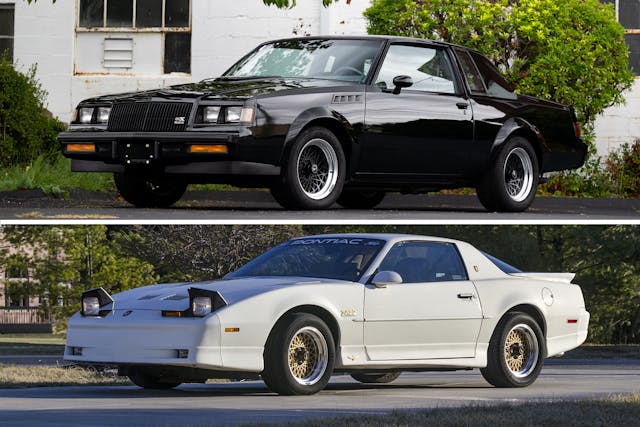












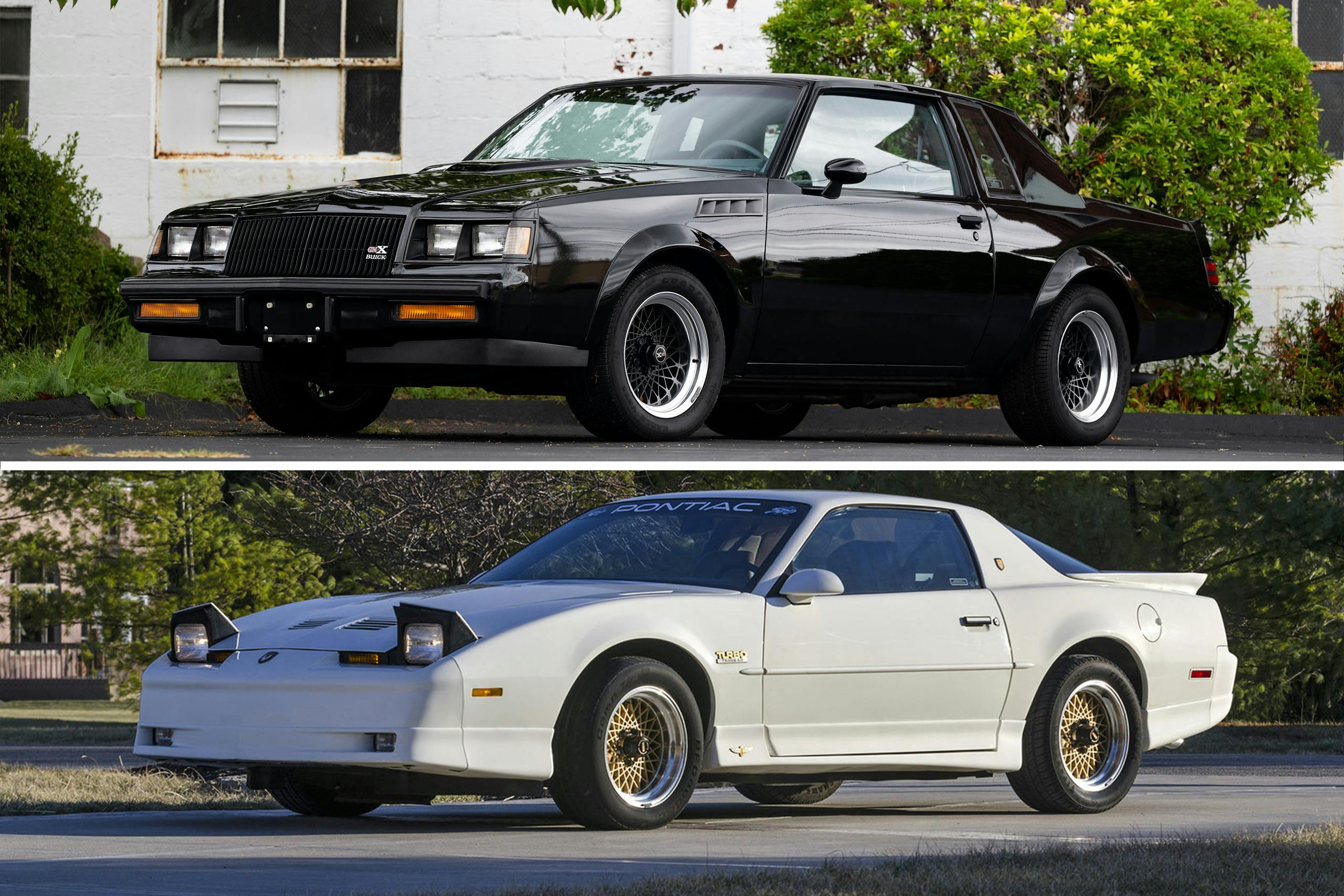
Wow, what pieces of crap. Dark days for Detroit and American Muscle.
The Buick looks better from the outside, recalling the peak of Muscle Cars that took a grocery getter into a street monster. But that interior is just weak. The TA, on the other hand, is just lowly all around. The best thing about it are the splitters out back.
Two hundred grand for a GNx? Conspicuous consumption meets a vomitorium.
‘Wow’, yourself…
You’re hashing my buzz!
‘Dark Days’, indeed…
Here were a couple of very bright lights, in an otherwise very unremarkable time, but bridged the way from Big Inch, full and mid-sized brutes, to DOHC, Turbo, Big-Braked, Fuel Injected, Computer Controlled, Silky Smooth, half-plastic, water-based painted, front wheel driven (or self-driven), electricity dependant, soul-less ‘conveyances’…
To Each His/Her Own…
“Harshing…”
Millennial ‘spellcheck’…
I once had an ’85 T/A and it looked wicked cool in black- and it handled like a go-cart. In spite of the new TPI, however, the 305 ci Chevy engine lacked torque. I regretted not waiting a year or two when it was replaced by the venerable 350 ci (and the early TPI bugs had been worked out). I admired the Turbo T/A when it came out, and might have bought one in black or maybe red, but the white didn’t appeal to me. white. Also: you had to be a limbo-star to get in and out of those T/A’s and Camaros! Boomers might like the GNX better unless you’re into yoga.
Egads! This back and forth sounds like an argument about which makes you more regular….Oatmeal or Raisin Bran. I am currently a Pontiac guy but I like Buicks too, but not with V 6 power and velour interiors.
Both are odd looking things.
I was a GM/Pontiac master tech back in the day and the only Turbo T/A I recall was the turds Pontiac produced in ’80 and ’81, with that stupid turbo hump in the hood. I had moved on before the higher performance V-6’s came along and I think that the earlier boat anchors probably tainted the later turbo editions. The 301 V-8’s that they used were supposed to be the most performance engineered ever and were physically different than any of the classic Pontiac engines. But . . . . .
That was the absolute Low Point for TA’s, followed closely by the 403″ Olds, with the sunken, non-operative, hood scoop…
Respect the GNX, but love the third gens, especially Camaro.
I had forgotten about the 3rd generation Trans Am turbo. This answers my recent what if question of building an alternative Z-28 with a 3800 V6, although I was leaning towards the supercharged one. A lighter and shorter engine would help handling and stand out from yet another LS swap. It’s surprising that the V6 is wider than than a small block but it may be a function of V angle. Now that I think of it, the 3.8 is derived from the aluminum BOP engine so a Rover V* might fit in an F body.
For the record around 1981 Pontiac had a Turbo Trans Am using the second generation body and a 301 V8, noteworthy for using a series of colored lights in the back of the hood scoop as a boost gauge.
You have to remember that Pontiac had a history of putting other GM engines in their vehicles when necessity called. The Olds 403 started going into the 1979 2nd generation T/A when Pontiac stopped production of its 400 that year – original Pontiac 400 1979 T/As have more value over their Olds powered brethren. Also Pontiac did throw a blower on their 301 for the ’80-’81 Turbo T/A as an option. Not so with Chevrolet which did not have its own turbocharged anything back then.
Look closely at the ’87 Monte Carlo Option Sbeet…
A Hot Rodder at Heart, I understand the quest for ‘something different’ under the hood, but it would take serious persuasion for me to replace an SBC 1, with, well, ANYTHING…
There are millions of combinations that would make yours unique, all of which bolt on. Not a big fan of LS, but nearly everyone else is, so plenty of options there. The Alloy Olds and Buick engines are NOT the same, and there are few similarities of either to the original Odd-Fire Buick V6…
That said, find your passion!
No, the GNX is an animal unto itself. The TA is, well, an engine swapped TA. Have always wanted a GNX, remember when they were new, but never wanted to pay the premium for one. To think you could buy a 69 Trans Am for less money makes it an easy decision.
Basically, the GNX, and the GN and the T-Type Turbo, are engine-swapped Regals. So? Nothing wrong with a great factory engine-swap!
Great article as I am a GN owner ( 1986 ) which. I prefer over the 87 not GNX due to amount made the T/A GTA was still a very nice car. Again welll done 👏🏼👏🏼
If you are actually planning to drive it and spend time in it, the Buick is the way to go. Plus, the Buick just looks cooler. The T/A is OK but it looks like a garden-variety 305 at 20 ft away.
If you’re the one driving the TTA, that look will be much more than 20ft, and growing longer with every 10,000rpm spin of the Turbo…
Just Sayin’…
Thanks for reminding me how lousy the 80s were.
Unless I really needed the extra space of the GNX (or GN), I would choose the Turbo T/A. The only non-V8 in Trans Am history, it didn’t let down the legend. Since I never much liked black cars, I far prefer the white of the T/A. And, as the article notes, the T/A has much better handling (and likely brakes) than the GNX. So, for me, no contest. The much lower price is really sweet icing on the cake.
As Sammy Hagar sang, the Trans Am is a “highway wonderland”!
Agree, the Wolf in Sheep’s Clothing approach works for me, but the JPS-look, first seen on a ’74 SD Pedestal Car at the Detroit Auto Show, was a real stunner…
Own a ’74 SD and a TTA, and the juxtaposition of Last Big Displacement, and First (and Only) Smallest Displacement TA appeals to me…
My only Black and Gold combo; a Cosworth Vega!
Please, no comments required…
I’m really trying to forget about the cars of the 80’s. But if I had to select one of these, give me the Buick Turbo lineup anytime.
As a Buick/Pontiac Dealer employee during that era, and handling most of the Zone Office cars, I had my hands on several dozen Turbo Buicks, and over a dozen TTA’s, including the lamentable 301’s…
All were exciting cars, in time of much malaise in the Automotive World, including GM…
Racing Pontiacs at the time, I was able to talk my way into a TTA, and have enjoyed it ever since…
Hindsight is always 20/20, but contemporaneous accounts are far more enlightening when passing judgment…
Handling, braking, acceleration, comfort, speed, reliability, panache, entertainment, safety, economy, exclusivity, and ‘cool’ are all the legacy of the one-time-only, TTA…
Enjoy!